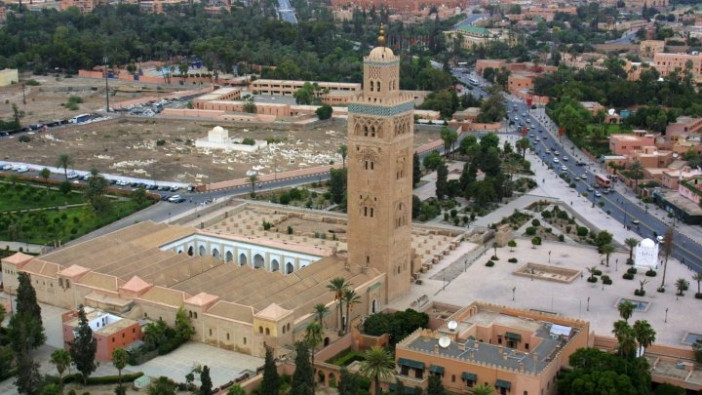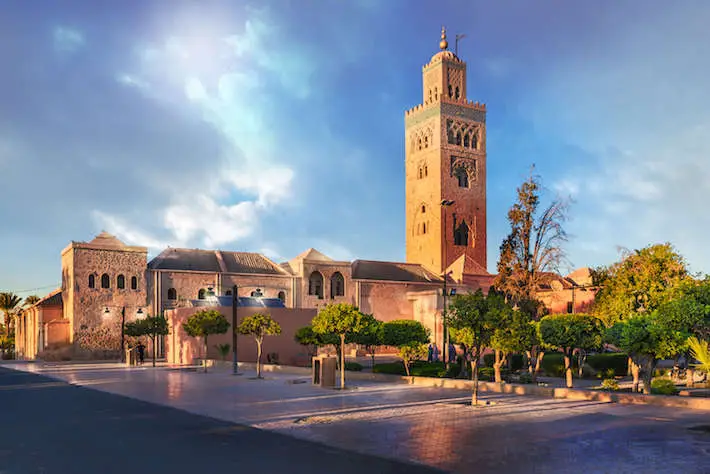The Koutoubia Mosque is one of the most popular and well-known tourist destinations in Marrakech. It is regarded by some as one of the most stunning structures in all of North Africa, and it has been imitated numerous times for its aesthetic and architectural features.
The Koutoubia is commonly shown in photographs as the visual representation of Marrakech because of its location and allure for tourists and Muslims who come to worship.
magnificent and located in the centre
In the older section of Marrakech’s Medina, the Koutoubia Mosque is situated near the start of Mohammed V Avenue (Southwest).
It can be reached by the El Koutoubia Trek, where all of Marrakech’s horse-drawn carriages park, and is also less than 200 meters from the renowned Jemaa El Fna Square.
The Mosque additionally tucks on its right an old mosque next to the Sidi Ali Belkacem cemetery and the Lalla Hasna garden (free access) at the back (struck by deconstruction for non-alignment with Mecca).
The former French Consulate and the French Consul’s residence are to its left, inside the Dar Moulay Ali Museum’s new cultural area (opened in May 2017).
The Mosque is a mandatory landmark on any stroll through the Medina or the modern section of Gueliz; it is impossible to miss.
It is also available to tourists from the terraces of the Riads, hotels, and restaurants of Medina. It is visible from the main roads of Gueliz and Marrakech.
Even 25 kilometers from the Ourika Road, it may be visible.
History of the Koutoubia Mosque : a path of journeys
Because it was initially constructed in the souk of manuscript merchants, it is occasionally also referred to as the Mosque of Booksellers.
Another version makes the false claim that several bookstores moved there once it was built (according to legend).
We are given information about its past through a number of testimonies.
Emir Almoravide (Berber dynasty), Ali ben Youssef who extended his influence from Mauritania to the south of the Iberian peninsula through all of Morocco, fortified the city of Marrakech and began building the Koutoubia Mosque in 1120.
His successor Abd al Mumin, the first Caliph of the Almohad dynasty (a sworn enemy of the previous dynasty), resumed building the mosque on the site of his predecessor’s former palace from 1141 to 1154 due to an alignment issue further east of the mihrab (prayer sanctuary indicating the direction of Mecca).
As a result, it is still possible to see the remnants of the earlier alignment strike adjacent to the modern mosque (primitive mosque of the Koutoubia).
In accordance with the customs of his dynasty, the Mosque underwent its last transformation under the rule of his successor grandson, the renowned Abu Youssef Yacoub El Mansour (about 1196) both on the outside and in its interior adornment.
Additionally, it should be noted that two other well-known mosques in Marrakech were constructed during the reign of Yacoub El Mansour and at the same time, the Koutoubia was completed: the mosque with the golden apples in the Kasbah neighbourhood close to Bad Agnaou and the mosque of El Mouassine in the Mouassine district.
The Moroccan Ministry of Culture oversaw the Mosque’s most recent repair in 1990, and more recent exterior installations were made in 2017.
Following the refurbishment of the Medina, work was done on the plaza leading to the entrance and at the back of the building in order to provide access to the garden.
respect of traditions and grandeur
dimensions :

– 90 meters long
– 60 meters wide
– 77 meters high (at the highest point of the spire) or 69 meters high at the top of the minaret
– capacity of more than 20,000 prayers
The Koutoubia Mosque’s design, which will be replicated for the Giralda Mosque in Seville (Andalusia Spain) and the Hassan II Tower in Rabat, Morocco, also serves as an illustration of its construction in hewn stone from the schistose sandstone hills near Marrakech (especially in the new part of Gueliz).
Construction Reference
It adheres to the T-shaped design (also known as the hypostyle plan or arabic plan), which was the same building plan used for the Great Mosque of Kairouan in Tunisia, which was built in 670 and served as a model at the time.
– large interior courtyard
– peripheral portico of columns surrounding the courtyard
– large prayer room with 17 naves perpendicular to the qibla wall (giving a sense of the direction of Mecca)
– mihrab, a deep sanctuary at the bottom of the qibla wall indicating the direction of the Kaaba (Mecca)
– minaret with a square section accessible by an inside staircase to the top
Koutoubia Minaret :

It should be emphasized that the meaning of the lantern at the summit of the minaret, which is topped by a jamur (in the form of an arrow penetrating 3 gilded brass balls), is open to debate.
- a portrayal of the three largest mosques in the Arab world: the Kaaba (Mecca), Medina, and Al Quds (Jerusalem).
– representation of the 3 elements of life : water, air and fire.
– the golden balls would have been made from all the jewellery of Yacoub el Mansour’s wife, who would have been guilty during Ramadan.
– the golden balls would be under the power of different geniuses to protect them from theft.
pure asceticism of Almohad art
The Koutoubia Mosque’s décor is exceedingly drab and austere, in keeping with the Almohad dynasty’s architectural principles, demonstrating the asceticism of the location.
Indeed, everything breath the stripping inside the building
– arches of the naves are not carved, remaining bare
– columns of the portico and the materials of the inner courtyard are raw
– the white color prevails everywhere
– the furniture is made of a simple minbar
The presence only of causes a difference in color:
Composed of intricately carved white marble slabs that extend from the mihrab to the back of the prayer hall, the dome’s upper portion is covered with colored earthenware tiles.
The minbar, a narrow stairway leading to the preacher’s platform that is exclusively utilized on Fridays, the day of prayer, is formed of various pieces of wood that have been inlaid with silver and pieces of inlay that have varying colors according to the variety of the species employed (this one is now visible in a corner of the El Badi Palace since its recent renovation).
Due to the color of the hewn stone facade, the relief sculptures and embellishments (particularly on the minaret), the ceramic bands, and the zelliges utilized, the outside decorating is more elaborate.

